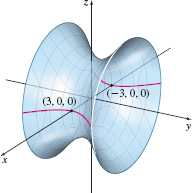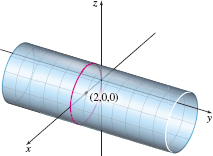EXAMPLE 4Graphing Quadric Surfaces Using a CAS
![]() Identify each equation and use a CAS to obtain its graph.
Identify each equation and use a CAS to obtain its graph.
- (a) 4x2−18y2+9z2=36
- (b) 4y2+9z2−36x2=0
- (c) x2+z2−4x=0
Solution
Divide both sides of the equation by 36, obtaining x29−y22+z24=1

This equation has three squared variables, one term negative, with 1 on the right, so it represents a hyperboloid of one sheet. Since the y term is negative, the y-axis is the axis of the hyperboloid of one sheet. See Figure 73.
The intercepts are (3,0,0), (−3,0,0), (0,0,2), and (0,0,−2). There are no y-intercepts.
The trace in the xz-plane is the ellipse x29+z24=1, and all traces parallel to the xz-plane are also ellipses. The trace in the xy-plane is the hyperbola x29−y22=1. The trace in the yz-plane is the hyperbola −y22+z24=1. Traces parallel to the xy- and yz-planes are also hyperbolas. The y-axis is the axis of the hyperboloid of one sheet.
We begin by writing the equation as \[ \begin{equation*} x^{2}=\frac{y^{2}}{9}+\frac{z^{2}}{4} \end{equation*}

Observe that the equation has three variables, all of which are squared, and no constant. This is the equation of an elliptic cone. See Figure 74.
751
The vertex of the cone is at the origin (0,0,0).
The trace of the elliptic cone in the yz-plane is the origin. Traces parallel to the yz-plane are ellipses centered on the x-axis. The trace in the xy-plane consists of the pair of intersecting lines x=±y3, and the trace in the xz-plane consists of the pair of intersecting lines x=±z2.

Since the y variable is missing, the surface is a cylinder. To identify it, we complete the square in x: \[ \begin{eqnarray*} x^{2}+z^{2}-4x &=&0 \\ ( x-2) ^{2}+z^{2} &=&4 \end{eqnarray*}
This is the equation of a right circular cylinder with a radius 2. The trace in the xz-plane is a circle of radius 2 and with its center at the point (2,0,0). See Figure 75.